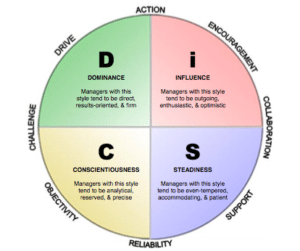Understanding your behavior style can help you play to your strengths and find ways to anticipate and even mitigate your challenges.
At Jamesson Solutions, we have found the DiSC Profile to be a powerful and easy-to-understand resource to learn about your behavioral style and how it affects others, to become aware of your reactions to other behavioral styles, and to adapt your behavior to create more positive interactions and outcomes.
The DiSC Profile can be helpful in a wide range of scenarios, such as managers seeking to get the most out of their teams, teams that are at odds internally or with other teams, and individuals who want to improve awareness of how their behavior styles affect others in order to be more effective in their careers.
The heart of the DiSC Profile is four behavioral dimensions:
D: Dominance
i: Influence
S: Steadiness
C: Conscientiousness
The below graphic gives a quick view of these four dimensions and how they operate:
Assess yourself
Take a look at the following DiSC Behavioral Styles – Strengths and Challenges and see if you can assess your own personality profile. Most people are a combination of two styles. A few are extremely oriented toward one style. A few may exhibit traits from three styles. See if you can find two traits that you feel are a good match for your personality style. Di are the extraverted styles and SC are more introverted.
DiSC Behavioral Styles – Strengths and Challenges
If you are a high “D” (Dominance) you tend to be competitive, assertive, results-oriented, independent, direct and brave about the choices you make. You may sometimes be perceived as controlling, demanding, impatient, and too tough. Under pressure, you might become blunt and sarcastic with people when they don’t meet your standards. You may appear to show little concern for feelings and relationships.
If you are a high “i” (Influence) you tend to be energetic, animated, charismatic, optimistic, persuasive, expressive and friendly. You may sometimes be perceived as emotional and impulsive. Your enthusiasm may get you in trouble because you may lose sight of business goals in order to maintain a harmonious climate. Giving bad news might be very difficult for you.
If you are a high “S” (Steadiness) you tend to be reliable, supportive, calm, amiable, persistent yet patient, loyal and sincere. You may sometimes be perceived to be too careful or too loyal to be open to new ideas. You may get bogged down by detail, be bound by procedure, be too reliant on established precedent before taking action.
If you are a high “C” (Conscientiousness) you tend to be analytical, careful, exact, thorough, quiet, logical, and focused on compliance. You may also be perceived as a too-cautious perfectionist, distant, and withdrawn. Your drive for precision and accuracy may cause you to rely too much on detail and analysis, and you may come across as overly critical of others, even if you are not voicing your concerns.
Which one or two of these behavior styles do you think applies most closely to you?
Assess your Audience; Adjust your Style
Being aware of your own DiSC profile helps you communicate better with others. So you can imagine the advantage this awareness brings when you are making a presentation.
So let’s take your awareness of your own style and consider some presentation scenarios in which you might feel more comfortable or more challenged based on your audience’s expected style.
It’s highly unlikely you’ll find yourself in a room presenting to a group with identical DiSC profiles. But you can sometimes safely make certain generalizations. For example, sales and marketing people tend to be high D / Dominance and I / Intuitive, or to shorthand it, Di’s. People in research and development, engineering, or any service area where accuracy and precision are critical are more likely to be C / Conscientiousness and S / Steadiness, or CS’s.
So if you have self assessed as a Di, and you are going to be speaking to a group that is also likely to be Di, it’s going to be a high-energy presentation! It’ll be like that because of your own natural style, and because you know from experience that Di’s need dynamic presentations or they just might tune out.
Conversely, if you’re a Di and you are speaking to a group that is likely to be CS, you might want to tone down the gestures, the pacing and the volume (without sacrificing accessibility, particularly in large audiences). Otherwise you might come across as too bold or aggressive, as trying to hard sell an idea, or as being overbearing and arrogant.
If you tend toward the CS you have some traits that are very appealing in a speaker. As an S, your natural warmth puts people at ease, and helps you to quickly build a connection. But for Di’s you might come across is low energy or too slow to keep their attention.
As a C, you are very likely to be well-prepared, and your presentation content will be accurate and fully fact-checked. But you’ll need to make sure you’re making eye contact with audience members all around the room, and you might need to overcome some discomfort with making larger gestures (that audience members can see) and with moving around your presentation area rather than hiding behind a podium.
Awareness = Advantage
The more you learn about your own behavioral styles and how they affect your interactions with others, the more you’ll also understand how to apply that knowledge to giving presentations. Combine that awareness with the ability to assess on a general level the likely behavioral styles of your audience, and you are on your way to creating presentations that don’t just inform, but also enlighten.
For more info: Presentation Basics, 6 Elements of Successful Presentations



